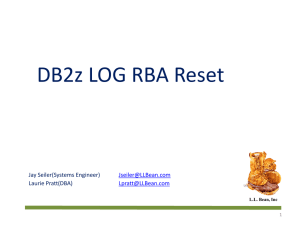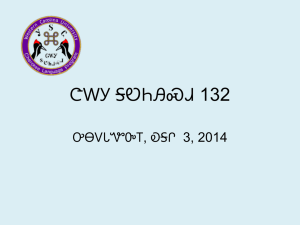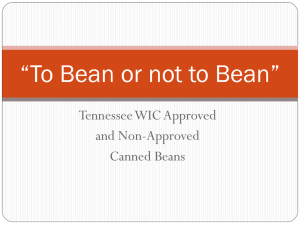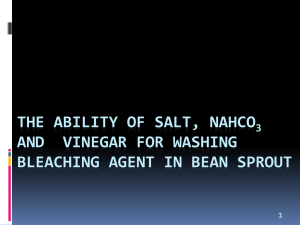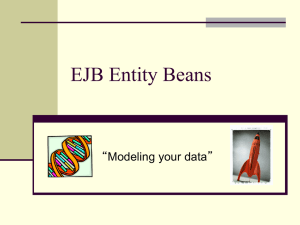Bean Varieties - Teaching Seeds
advertisement
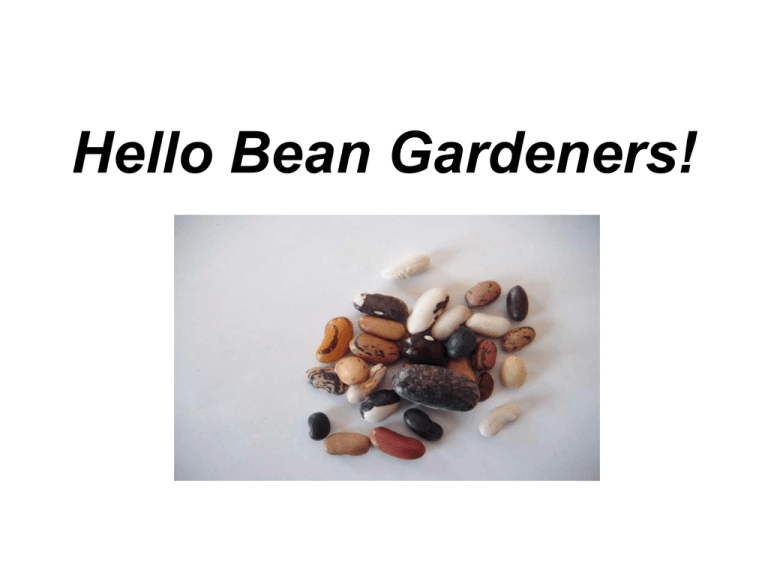
Hello Bean Gardeners! Did you know that beans are one of the oldest cultivated plants on our planet? People have been farming beans for thousands of years! Picture source http://www.dailykos.co m Did you know that there are over 40,000 different varieties of beans? Picture source http://www.uwlax.edu Did you know that you can save the seeds from the plants you grow and then plant them again next year? I hope you will try this! By planting these beans and saving their seeds, you are a part of this history! HAVE FUN! Provider This is a bush variety of green bean. It was introduced in 1965 by the United States Department of Agriculture and it is still one of the most popular green beans today. Picture source - http://www.seedlibrary.org Cannellini This bush bean is a shell bean which means it is generally used as a dried bean. This variety dates back before 1900. It is also known as Cannelone. Black Valentine This is a bush variety of green bean. It gets it's name from the seeds which are black in color. It was introuced in 1897 by Peter Henderson and Company. Picture source - http://www.seedsavers.org/ Greencrop This is a bush variety of green bean. It has a flat pod which is called a “Romano” type of bean. It was introduced in 1957 and was bred at the University of New Hampshire by Albert F. Yaeger and Elwyn Meader. Picture source http://www.burpee.com Hutterite This bean variety was grown and passed on by Hutterite Christians. These are Christians who follow the teachings of their leader Jakob Hutter. They emigrated to North America in the 1870s and brought the beans with them.There are still Hutterites living in parts of Canada and northern United States. Royal Burgundy This is a bush variety of bean. The pods are purple, but they will turn green after a couple minutes of cooking! Picture source - https://www.seedsofchange.com Tiger Eye This bush bean is a shell bean which means it is generally used as a dried bean. It is known as Pepa de Zapallo in Spanish. This variety is originally from Argentina and Chile. Concador Yellow This is a bush style “haricot” or French bean. The pods are yellow in color. Picture source - https://www.seedman.com Kenearly This bean was developed at a research station in Kentville, Nova Scotia. The date is uncertain but it was before 1989. It is similar to a bean called Yellow Eye, due to the spot on the seed. Golden Rocky This is a bush style wax bean. Wax beans were first developed in the 1830s. Golden Rocky is an heirloom variety from France where it is called Beurre de Rocquencourt. Picture source - http://www.rareseeds.com Bush Blue Lake 274 This is a bush variety of green bean. It was introduced in 1961 and was developed from a pole bean of the same name. Picture source http://www.burpee.com Jacob's Cattle This bush bean is a shell bean which means it is generally used as a dried bean. This is a popular heirloom variety in New England and from Prince Edward Island. A legend says that it was a gift from the Passamaquoddy Indians in Maine to Joseph Clark, the first white child born in Lubec, Maine. It may have originally come from Native Americans in the Southwest United States. The name is based on the biblical story of Jacob and the spotted cattle because the markings on the bean seed are thought to resemble cattle. Black Coco This bush bean is a shell bean which means it is generally used as a dried bean. It can also be picked as a fresh green bean. Black Coco gets it's name from the color of the dried bean. Velour This is a bush style “haricot” or French bean. It gets it's name from the texture of the pods which are silky. Picture source - http://ambafarm.com Northeaster This is a romano style (flat pod) green bean. It may also go by the name of Kwintus. Dragon Langerie This is a bush style wax bean. Wax beans were first developed in the 1830s. This bean, which is also known as Dragon's Tongue, dates back to the 1800s. It was introduced first in the Netherlands. The pods will become more colorful if they have enough sun so be sure to give this plant some room to grow! Picture source - http://www.seedsavers.org Kentucky Wonder This is a pole style bean. Kentucky Wonder is also known by the name Old Homestead. It received it's current name in 1877 from James J. H. Gregory who was a seed grower in Marblehead, Massachusetts. The bean has a nutty flavor. True Red Cranberry This pole bean is a shell bean which means it is generally used as a dried bean. It can be challenging to grow but it is considered one of the best beans for baking. It was described in a 1700s gardening book and is probably one of our oldest bean varieties! It was most likely a Native American bean. True Red Cranberry is listed on Slow Foods' Ark of Taste which is a list of historically important foods. Picture source - http://commons.wikimedia.org Soldier This bean has been grown for generations. The name comes from the red markings on the seed which some people think look like a tiny toy soldier. Rattlesnake This is a pole style bean. The name comes from the pods which have purple streaks and are thought to resemble a rattlesnake. The beans are also striped. Picture source http://www.burpee.com Blue Coco This is a pole style bean which dates back earlier than 1775. It is a French heirloom. Scarlet Runner This is a climbing bean that can be eaten, but it is also sometimes grown just for the flowers. The flowers are red in color and often attract butterflies and hummingbirds. This variety was grown as early as 1750 by the colonists. President Thomas Jefferson was also reported to have grown this bean in 1791. Picture source - http://www.johnnyseeds.com Red Noodle Yard Long This is a pole style bean that can grow up to 18 inches in length. First grown in Asia, this bean really likes warm temperatures. Picture source - http://www.rareseeds.com Jackson Wonder This variety is a Lima Bean. Lima beans were first cultivated in Peru over 6,000 years ago. This variety, Jackson Wonder, was introduced in 1888 by an Atlanta, Georgia farmer named Thomas Jackson. The flowers on this bean are sweet smelling and attract butterflies. Vermont Cranberry This bush bean is a shell bean which means it is generally used as a dried bean. This bean has been a traditionally grown bean in Vermont and dates back to at least 1800. Picture source - http://www.plantersplace.com Taylor Dwarf Horticultural This bush bean is a shell bean which means it is generally used as a dried bean. This variety is also known as Speckled Bays. It dates back to the 1700s and has cream colored pods that will get red splashes on them when they are ripe. Calypso This bush bean is a shell bean which means it is generally used as a dried bean. This variety is also called Orca or Yin-Yang bean because of the black and white coloring on the bean seed. Picturer source - https://awhaley.com Ireland Creek Annie This bush bean is a shell bean which means it is generally used as a dried bean. It was introduced to Canada in the 1920s from England. It's name, Ireland Creek Annie, comes from the place it was grown in British Columbia during the 1930s. Red Kidney This bush bean is a shell bean which means it is generally used as a dried bean. This variety was developed at Cornell University. Picture source http://msue.anr.msu.edu Midnight Black Turtle This bush bean is a shell bean which means it is generally used as a dried bean. This variety was introduced by Cornell University. They developed it from the original Black Turtle bean which was first offered in 1832 by Grant M. Thorburn. This variety doesn't sprawl out as much as the original.


